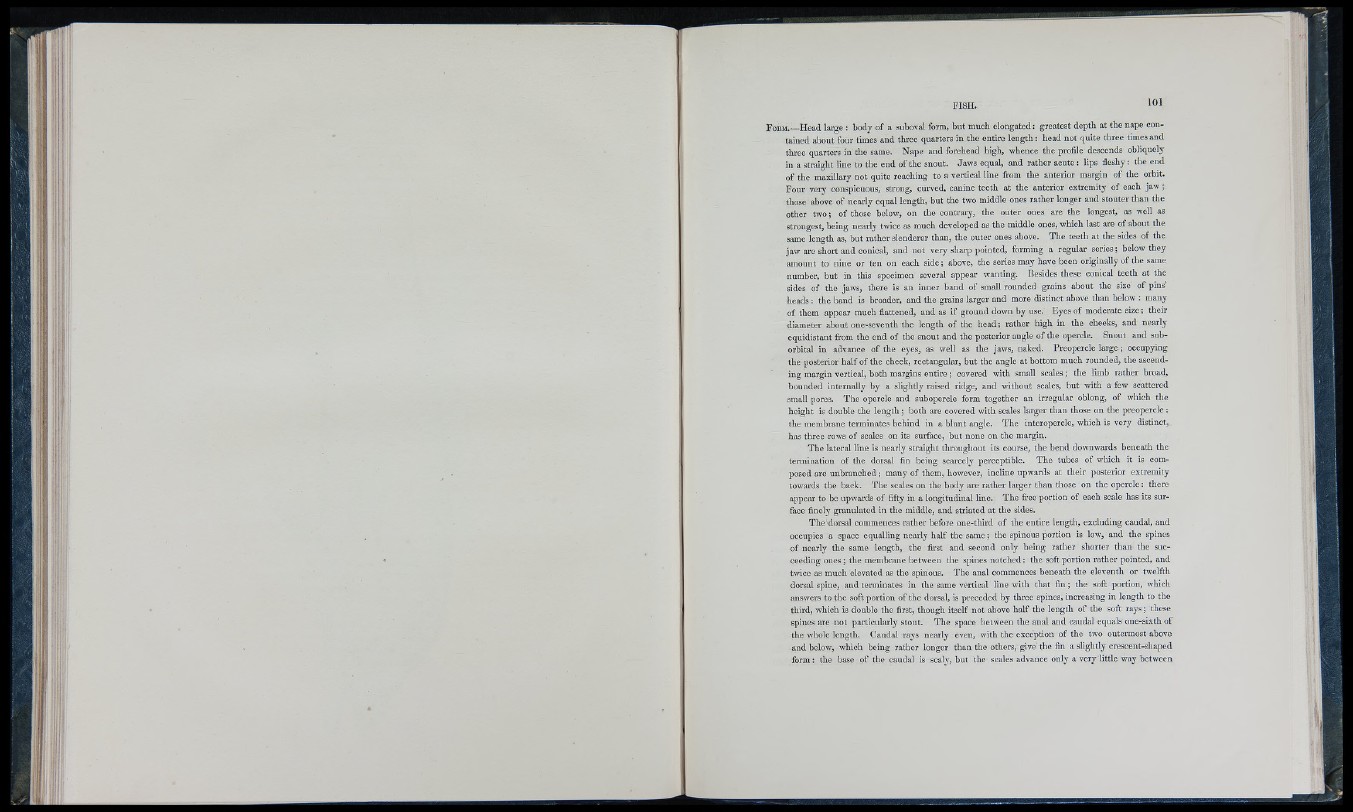
lo i
F orm.— H ead large : body of a suboval form, but much elongated : greatest depth at the nape contained
about four times and three quarters in the entire length : head not quite three times and
three quarters in the same. Nape and forehead high, whence the profile descends obliquely
in a straight line to the end of the snout. Jaw s equal, and rather acute : lips fleshy : the end
o f the maxillary not quite reaching to a vertical line from the anterior margin of the orbit.
F our very conspicuous, strong, curved, canine teeth at the anterior extremity of each jaw ;
those above of nearly equal length, but the two middle ones rather longer and stouter than the
other two ; of those below, on the contrary, the outer ones are the longest, as well as
strongest, being nearly twice as much developed as the middle ones, which last are of about the
same length as, but rather slenderer than, the outer ones above. T he teeth at the sides of the
jaw are short and conical, and not very sharp pointed, forming a regular series ; below they
amount to nine or ten on each side ; above, the series may have been originally of the same
number, but in this specimen several appear wanting. Besides these conical teeth at the
sides of the jaws, there is an inner band of small rounded grains about the size of pins’
heads : the band is broader, and the grains larger and more distinct above than below : many
of them appear much flattened, and as if ground down by use. Eyes of moderate size ; their
diameter about one-seventh the length of the head; rather high in the cheeks, and nearly
equidistant from the end of the snout and the posterior angle of the opercle. Snout and suborbital
in advance o f the eyes, as well as the jaws, naked. Preopercle large ; occupying
the posterior half of the cheek, rectangular, but the angle at bottom much rounded, the ascending
margin vertical, both margins entire ; covered with small scales ; the limb rather broad,
bounded internally by a slightly raised ridge, and without scales, but with a few scattered
small pores. T he opercle and subopercle form together an irregular oblong, of which the
height is double the length ; both are covered with scales larger than those on the preopercle :
the membrane terminates behind in a blunt angle. The interoperele, which is very distinct,
has three rows of scales on its surface, but none on the margin.
T he lateral line is nearly straight throughout its course, the bend downwards beneath the
termination of the dorsal fin being scarcely perceptible. T he tubes of which it is composed
are unbranched; many of them, however, incline upwards at their posterior extremity
towards the back. T he scales on the body are rather larger than those on the opercle : there
appear to be upwards o f fifty in a longitudinal line. The free portion of each scale has its surface
finely granulated in the middle, and striated at the sides.
T he dorsal commences rather before one-third o f the entire length, excluding caudal, and
occupies a space equalling nearly half the same; the spinous portion is low, and the spines
of nearly the same length, the first and second only being rather shorter than the succeeding
ones ; the membrane between the spines notched : the soft portion rather pointed, and
twice as much elevated as the spinous. The anal commences beneath the eleventh or twelfth
dorsal spine, and terminates in the same vertical line with that fin ; the soft portion, which
answers to the soft portion of the dorsal, is preceded by tliree spines, increasing in length to the
third, which is double the first, though itself not above half the length of the soft rays ; these
spines are not particularly stout. T he space between the anal and caudal equals one-sixth of
the whole length. Caudal rays nearly even, with the exception of the two outermost above
and below, which being rather longer than the others, give the fin a slightly crescent-shaped
form : the base of the caudal is scaly, but the scales advance only a very little way between